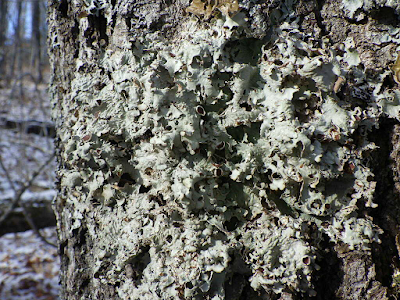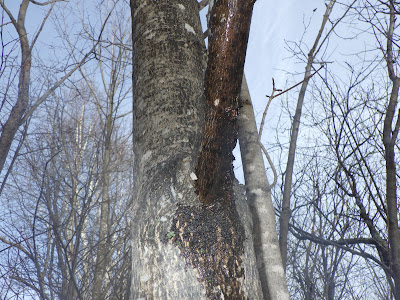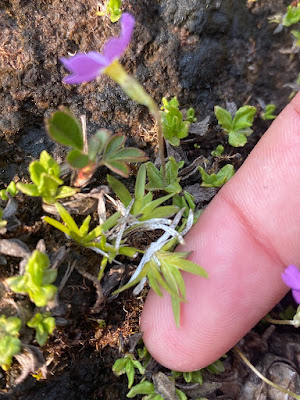Ever since I first ran into Abrothallus peyritschii a few moths ago, I have been obsessively searching for more lichenicolous fungi. They are quite an interesting group of organisms; being so understudied, along with being rather small and indistinct always makes them fun to stumble across.
I had been researching some species to go and try to find in the field. One of the species that I read about was Abrothallus halei; the holotype for which was collected by Cliff Wetmore just east of Hare Lake back in 1999, but wasn't described until 2010. Apparently there have only been collections from MN, WV, ME, and Norway, so I figured it would be worth the effort to go and look for. Little did I know the adventures that that would bring about!
The first trip out to Goldeneye Lake was on Jan. 4. I had been there a couple of months before on a natural history hike with Charlie. From that I knew that there were quite a few older maple trees absolutely covered with tree lungwort, I figured it'd be a great habitat for smooth lungwort, (the host lichen of A. halei) a rather rare lichen which prefers old growth forests and especially the craggy bark of sugar maple, see here. After climbing up the ridge where all the maples were, it didn't take long to find some decent patches of smooth lungwort, and a little later I found what I assumed was A. halei. However, later on John Thayer identified it as a species of Sclerococcum, most likely S. ricasoliae. The Sclerococcum form discoid acomota on the thallus, whereas the Abrothallus form spherical ascomota on the apothecia.
Smooth lungwort (Ricasolia quericizans) growing on a mature sugar maple
Sclerococcum ricasoliae growing on the thallus of smooth lungwort
On that first trip, I found a couple other interesting lichenicolous fungi.
Plectocarpon lichenum growing on tree lungwort (Lobaria pulmonaria)
Sphinctrina sp. growing on a pore lichen (Pertusaria sp.)
Then on Jan. 17 Joe and Nolan joined in on the adventure. We went back to the same spot to see how abundant S. ricasoliae was, in case we wanted to make any collections of it later on when there isn't so much snow covering everything. We found it quite a few times and it seems to be somewhat common at this location. While we were searching, Nolan found some black splotches that looked different and wondered what they might be. I said that they definitely weren't the Sclerococcum, but looked like they were fungal. Alejandro Huereca Delgado commented on the
iNat post, suggesting a species of Arthonia, potentially A. subconveniens, but more likely an undescribed species. He said that we should collect a sample so that he could further examine it.
The mystery fungus, probably an undescribed species of Arthonia
John Thayer made his way up that weekend on Jan. 20 to make said collection. Rachel, Nolan, and I accompanied him and we did some more exploring at the site. We collected a few samples that John then sent in to get examined. Hopefully we'll get more information about this species soon.
Finally, the other day on Jan 27 I returned to the site, planning on going to the other side of Goldeneye where I knew there were also lots of maples, to hopefully find A. halei. It took a looong time, but after many failed attempts I finally found it! The fungi was pretty discrete, very small and growing on the dying, blackened apothica. I continued up the road and explored the woods right next to the Trestle Inn. I found many of the same species of lichenicolous fungi on the smooth lungwort there, including another example of A. halei!
Some would say that this fungus looks pretty lackluster and isn't worth paying such attention to, but the journey to see it along with the interesting ecology of lichenicolous fungi like this give me a special appreciation for this species. Abrothallus can grow commensally or parasitically on their host lichens. The intricacies of these relationships vary by species and I would assume also depending on environmental conditions. From these observations I'd guess that A. halei is primarily parasitic since it only seems to grow on stressed/dying apothica... I wonder if these lichen are stressed as a result of being colonized by the fungi, or perhaps it is the other way around and the fungi is only able to infect specific individuals because they are stressed. I'd guess that it is probably a little of both.
Abrothallus halei growing on the apothica of smooth lungwort
Again, while I was out there I noticed a couple other species that I hadn't seen at the sight on any of the previous visits. Tremella evernia is a species that cause brain-like galls to grow on boreal oakmoss; beard-lichen parasite is another species that grows on usnea. I encountered both of these parasites a couple times. Another species I was hoping to see is Abrothallus usnea. Supposedly it acts as a hyperparasite on beard-lichen parasite. I'd guess that A. usnea is probably at this site, or at least not to far away, maybe I'll see it on the next adventure.
Tremella evernia causing a gall on boreal oakmoss (Evernia mesomorpha)
Beard-lichen parasite (Biotoropsis usnearum) on an Usnea sp.
Like I said at the beginning, lichenicolous fungi are so cool. There is so much more that is yet to be learned about them; new species to be discovered, new host associations to be found, expanding their known ranges, the potential for discovery seems endless. And just think, all these adventures and discoveries were brought about by a handful of naturalists, exploring a single area, looking at just one species of lichen. How many more species might be right in front of our eyes that nobody has slowed down enough to notice before?










Comments
Post a Comment